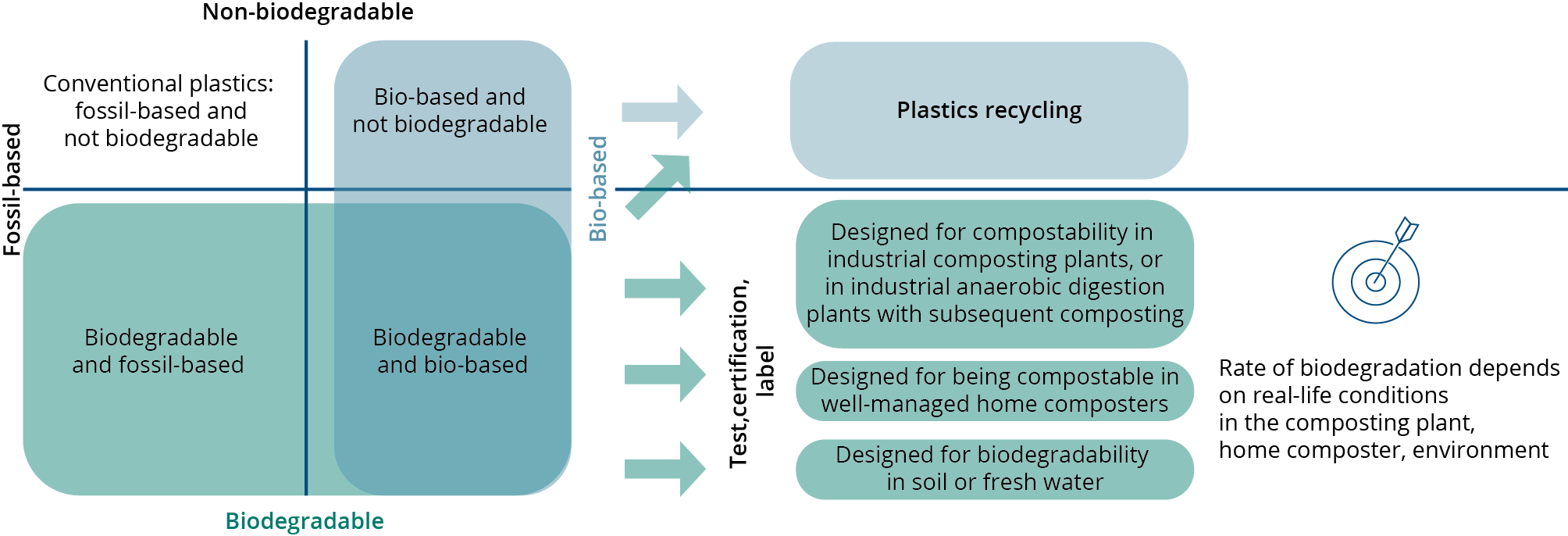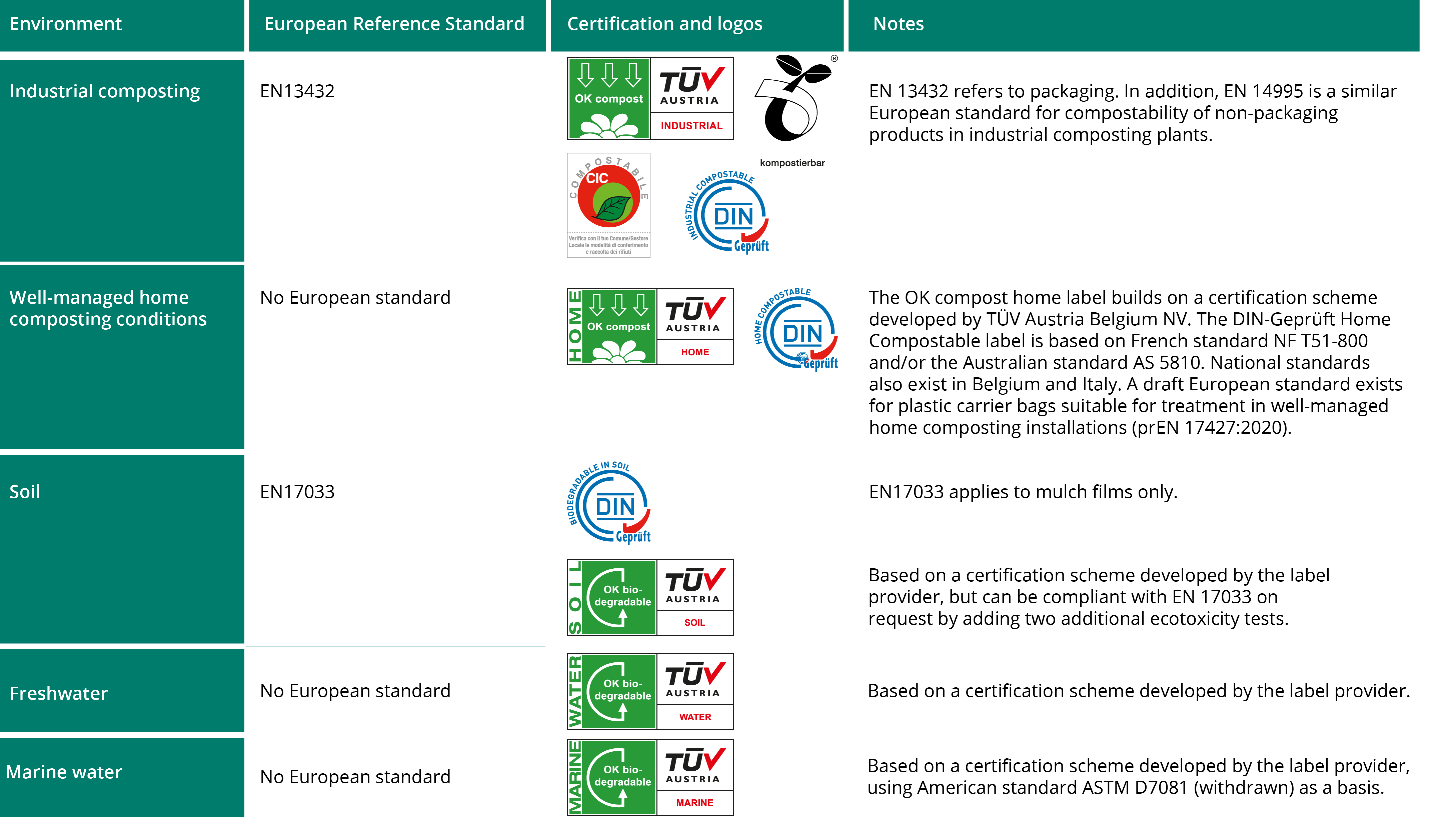What are the challenges?
Plastics are a key material in modern life. They are versatile, light and can be produced at relatively low cost. Currently, only about 1 % of plastics and plastic products on the global market are considered bio-based, compostable and/or biodegradable (European Bioplastics e.V., 2020b).
Most plastics continue to be made from fossil fuels in a process that contributes to increased greenhouse gas emissions along their value chain. Indeed, plastics pollute throughout their life cycle from production, to use and finally through their disposal.
Recycling rates of plastic are low and plastics leak into the environment through, for example, littering, improper waste management and wear and tear of products. They can stay in nature for many years and potentially enter the food chain. Contamination with plastic particles is a particular challenge in terms of keeping compost made from separately collected bio-waste clean (EEA, 2020).
Biodegradable, compostable and bio-based plastics are increasingly promoted as a solution to some of these challenges. More and more consumer products, such as plastic bags, packaging and single-use cups, are labelled as ‘compostable’, ‘biodegradable’ or ‘bio-based’. But what exactly do these terms mean? To what extent can biodegradable, compostable and bio-based plastics help solve the sustainability challenges posed by plastics? And do they create new ones?
Biodegradable, compostable, bio-based — what does it all mean?
Biodegradable and compostable materials can be broken down by microorganisms into water, carbon dioxide, mineral salts and new biomass within a defined period of time. Whether a biodegradable or compostable plastic item biodegrades and how quickly that happens, strongly depends on the conditions it is exposed to during disposal. These include temperature, duration, the presence of microorganisms, nutrients, oxygen and moisture (De Wilde et al., 2013; van den Oever et al., 2017).
Different types of biodegradable and compostable plastics are designed to biodegrade under specified conditions (Box 1). In other conditions, they might biodegrade slowly or not at all or fragment into microplastics.
Box 1. Overview of types of plastic
Biodegradable plastics are designed to biodegrade in a specific medium (water, soil, compost) under certain conditions and in varying periods of time.
Industrially compostable plastics are designed to biodegrade in the conditions of an industrial composting plant or an industrial anaerobic digestion plant with a subsequent composting step.
Home compostable plastics are designed to biodegrade in the conditions of a well-managed home composter at lower temperatures than in industrial composting plants. Most of them also biodegrade in industrial composting plants.
Bio-based plastics are fully or partly made from biological raw materials as opposed to the fossil raw material (oil) used in conventional plastics.
Non-biodegradable plastics last for long periods of time. They can disintegrate into smaller pieces, forming microplastics, and accumulate in the environment.
Oxo-degradable plastics include additives that, through oxidation, lead to their fragmentation into microplastics or chemical decomposition.
Biodegradable or compostable plastics can be produced from either bio-based or fossil raw material (feedstock) (Figure 1). They can be produced to have similar functionality to or the same functionality as conventional plastics (WRAP, 2020). The sustainability of bio-based materials, just as of fossil-based plastics, depends on production practices, the products’ lifetime and end-of-life treatment (EEA, 2018). The term bioplastics is sometimes used for plastics that are either bio-based or biodegradable, or both (European Bioplastics e.V., 2020c). Given that these have very different properties, consumers could misunderstand the rather vague term ‘bioplastics’.

Source: ETC/WMGE and EEA.
Standards, labels and logos
European standards exist for assessing the compostability of plastics in industrial composting plants and the biodegradability of mulch films in soil for use in agriculture. Plastic materials or products fulfilling these standards may be certified and labelled accordingly (Table 1). To date, there is no European standard for assessing biodegradability in water. This is because the very variable conditions in freshwater and marine environments make standardisation difficult. However, the International Organization for Standardization is developing standards for testing biodegradability in specific marine environments.

Sources: TÜV AUSTRIA (2012a, 2012b, 2012c, 2013, 2019), DIN CERTCO (2016, 2017, 2018), Hilton et al. (2020), European Bioplastics e.V. (2019, 2020a, 2020b), CIC (2020). Logos reproduced with permission from TÜV Austria Belgium NV, European Bioplastics e.V., DIN CERTCO and CIC — Consorzio Italiano Compostatori.
Any claim of compostability or biodegradability should be precise and clearly related to the conditions under which the properties apply. Certifications guarantee that a product complies with an established standard or a set of conditions defined by the certifier. Nevertheless, real-life conditions can differ from these conditions and hamper biodegradation. This is especially of concern for home composting and for biodegradability in soil and water (Hilton et al., 2020).
Industrially compostable plastic products are designed to biodegrade under specific, controlled conditions in industrial composting plants. They do not necessarily (fully) compost in semi-controlled home composters or in the uncontrolled conditions of the natural environment. Although labels for industrial compostability usually refer to the standard used for certification, bad practice exists in the consumer market (Hilton et al., 2020). Providing additional information beyond the label itself would enhance understanding of how to dispose of the product.
Consumer behaviour
The differences between ‘compostable in industrial composting plants’, ‘home compostable’, ‘biodegradable in soil/freshwater/marine water’ and ‘bio-based’ are not easy to understand. For example, in a survey in Germany, 58 % of respondents thought that all ‘bioplastics’ were compostable (Blesin et al., 2017). Many consumers struggle to understand environmental claims and labels and do not differentiate between certified labels and self-declared labels (EC et al., 2014).
Experience from bio-waste (food and garden waste) collection shows that measures that depend on consumer behaviour are only adopted by a certain share of the population. To increase participation, the measures need to be accompanied by customised awareness-raising and information campaigns (EEA, 2020). Teaching children about labels and correct waste sorting can also play an important role. How to correctly dispose of products made of industrially compostable plastics also depends on the local waste management system and treatment infrastructure.
Therefore, repeated, targeted and clear communication with consumers is needed to explain the differences between compostability and biodegradability in different environments. Additional measures, such as standardised colouring for industrially compostable bags or QR codes providing further information, could improve clarity.
There are fears that consumers might misunderstand biodegradability or compostability claims as a ‘licence to litter’, but evidence supporting or refuting these fears is scarce (Hilton et al., 2020).
Waste management of biodegradable and compostable plastics
A circular economy retains the value of products and materials in the economy as much as possible. Although biodegradable and compostable plastics are technically recyclable, they are currently not recycled back into plastic material. Rather, they are treated as an impurity in the recycling of conventional plastics when collected together. Increasing market shares in future could aggravate the situation but could also make recycling of certain biodegradable or compostable plastics economically viable (Crippa et al., 2019). Nevertheless, further research, innovation and investment into recycling plastics is required.
Anaerobic digestion treats bio-waste without the presence of oxygen. It generates a digestate and biogas, which is a renewable energy source.
Although compostable plastics do not add nutrient value to compost (Burgstaller et al., 2018), they have a role in supporting sustainable bio-waste management. Bio-waste from households and other sources is increasingly collected separately from other waste across Europe. Digesting or composting bio-waste in industrial digestion or composting plants results in compost or digestate that can be used as soil improver and fertiliser, as long as they comply with national quality requirements. Separate collection or home-composting of bio-waste will be mandatory in all EU Member States from the end of 2023 onwards (EU, 2018).
Contamination with conventional plastics is an increasing challenge for compost quality (EEA, 2020). Replacing conventional plastics with certified compostable plastics for items that are often mixed with or attached to food waste, e.g. fruit stickers or tea bags, can help reduce contamination with conventional plastics (Crippa et al., 2019; Hilton et al., 2020).
Experience shows that using compostable plastic bags increases the capture rate of food waste because consumers find them convenient (Burgstaller et al., 2018). Some municipalities and waste collectors therefore recommend or require the use of certified compostable plastic bags for collecting bio-waste. Others will not accept compostable plastic bags. The strategy also depends on the existing bio-waste treatment infrastructure (e.g. typical composting period, treatment capacity, anaerobic digestion technology, strategy for removing impurities, including plastics) (Burgstaller et al., 2018; Hilton et al., 2020).
Implications for Europe’s policy actions
The 2020 circular economy action plan envisages creating a clear policy framework for plastics with biodegradable properties (EC, 2020). This may entail:
- harmonised rules for defining and labelling compostable and biodegradable plastics
- finding out in which applications using such plastics has environmental benefits.
For example, compostable plastics have a potential environmental benefit in specific applications such as bio-waste collection bags and items attached to bio-waste (Hilton et al., 2020). This is provided that the technical set-up of the local bio-waste management infrastructure guarantees effective collection and biodegradation of such plastics. Agricultural mulch film is another example. Using biodegradable mulch film instead of conventional mulch film can potentially avoid long-term plastic accumulation in soil. This is because mulch films made of conventional plastics are difficult to completely remove from farmland (Crippa et al., 2019).
A labelling system needs to avoid confusing consumers. Awareness-raising campaigns and clear communication with consumers will improve their understanding of the labels used on plastics and ensure their correct disposal. Applications that increase the risk of littering or contamination of compost with plastics (including those that are compostable or biodegradable) might have to be restricted. They may need to be prevented from being marketed as biodegradable or compostable.
Biodegradable and compostable plastics can offer environmental benefits if developed for specific situations and applications. Further improvements are urgently needed. The market for such products is likely to grow in the coming years. However, compostable and biodegradable plastics are far from providing a general, stand-alone solution to the challenges Europe faces with plastics today.


Document Actions
Share with others